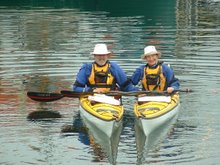From Harstad, we continued west along Highway 83, travelling through beautifully rolling countryside with many farms. We took the ferry from Reynes to Flesnes to cross Gullesfjorden. We eventually rejoined E10, and crossed another impressive bridge to Sortland on Hadsefjorden. We had stopped here on our journey north aboard the Hurtigruten.
Our plan for today was to visit Vesteralen, or specifically Langoya. Somewhere along the way, we had been led to believe that the countryside here would be relatively flat, and not as interesting as the Lofoten Islands. We must not have heard right. While the mountain elevations are only 450 to 750 m, the snow-capped mountains were quite impressive poking through the clouds into the sunlight.
With our map in hand, we explored along several roads off the main highway, e.g.,
- from Froskeland north to Myre, and then to Nyksund and Sto
- from Krakberget north to Utskor
- from Rise north to Malnes, Nykvag and Hovden
Nyksund is an abandoned fishing village that is attempting to come back as a possible tourist and summer destination. As in Newfoundland (circa 1958 - 1962), there was a government relocation program here in 1970 to close outports, and move people to centralized population centres. Nyksund was abandoned at this time. The 35+ years since then has not been kind to many of the buildings. It’s a relatively long drive into Nyksund along a narrow gravel road, and the reconstruction has struggled due to the lack of funds. It will likely be a few year before Nyksund is fully restored.
Sto is a distinctive fishing village located at the northern tip of one of the many peninsulas on Langoya. On one of the distant islands, an old lighthouse can be seen. We ate lunch by the old church, looking out over the turquoise sea past beautiful white sandy beaches and rocky skerries.
Utskor was another abandoned fishing village that has been reoccupied by summer residents. On the way into Utskor, we drove past an active plant after winding our way up and down through a twisting mountain pass. We’ve driven by many such plants, and all seem to be well kept and active, likely associated with salmon farming and the winter cod fishery. It’s great to see so much employment coming from the sea after so many generations of fishing. Apparently, Norway has severely regulated their fishing for many years to ensure the future viability of this industry.
Hovden was another active fishing community with thousands of cod drying on the racks.
Further west, we found more white sandy beaches near Straume, and many small farms. When we couldn’t find the ferry marked on the map from Guvag to Stokmarknes, we then retraced our steps around Langoya to Sortland, and on to Stomarknes. Here, we crashed for the night in a relatively expensive, but very average hotel, the only one in town. Our dinner aboard an old whaling ship was also interesting, i.e., we had our first taste of stockfish (reconstituted dried cod).
Overall, we were very impressed by the rugged beauty of the northern shores of Langoya. The mountains poking through the clouds, the white sandy beaches and turquoise inshore waters, the abandoned outports, the fish farming and numerous active flakes, the farms in the valleys and along some shorelines, and the sheep were some of the day’s highlights.
Friday, June 8, 2007
Subscribe to:
Post Comments (Atom)

No comments:
Post a Comment